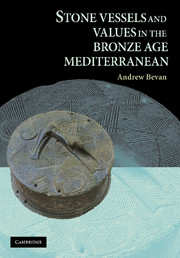Book contents
- Frontmatter
- Contents
- Acknowledgments
- 1 Introduction
- 2 Agreeing on Things
- 3 Moving People, Objects, and Ideas
- 4 Making Stone Vessels
- 5 The Third Millennium
- 6 The Earlier Second Millennium
- 7 The Later Second Millennium
- 8 The Rough and the Smooth: Stone Vessels from a Comparative Perspective
- 9 Forging Value and Casting Stones
- Appendix
- Notes
- Bibliography
- Index
8 - The Rough and the Smooth: Stone Vessels from a Comparative Perspective
Published online by Cambridge University Press: 14 August 2009
- Frontmatter
- Contents
- Acknowledgments
- 1 Introduction
- 2 Agreeing on Things
- 3 Moving People, Objects, and Ideas
- 4 Making Stone Vessels
- 5 The Third Millennium
- 6 The Earlier Second Millennium
- 7 The Later Second Millennium
- 8 The Rough and the Smooth: Stone Vessels from a Comparative Perspective
- 9 Forging Value and Casting Stones
- Appendix
- Notes
- Bibliography
- Index
Summary
The preceding chapters have covered a large area and an extended period of time to make some explanatory links across the whole Bronze Age eastern Mediterranean. This chapter takes such a comparative approach to its logical conclusion by considering, albeit rapidly, the roles played by stone vessel traditions across the world and throughout human history. In this regard, it is important to explore comparisons not only with other Mediterranean and Middle Eastern stone vessel industries but also with those in wholly separate parts of the world, so that we can distinguish patterns of convergent usage driven by similar conditions from those that are part of an inherited or diffused cultural tradition. In other words, while such a perspective cannot hope to be comprehensive, it aims to distinguish the smooth cross-cultural themes and those rougher idiosyncrasies specific to the cultural development of the Bronze Age eastern Mediterranean.
Figure 8.1 presents the result of a literature search on pre-twentieth century stone vessel industries across the world, ignoring simple mortars and palettes. No doubt, it is very far from complete and reflects a degree of investigative bias in favour of regions close to the eastern Mediterranean, but it nonetheless suggests that such objects have a very wide geographic distribution.
- Type
- Chapter
- Information
- Stone Vessels and Values in the Bronze Age Mediterranean , pp. 166 - 184Publisher: Cambridge University PressPrint publication year: 2007



